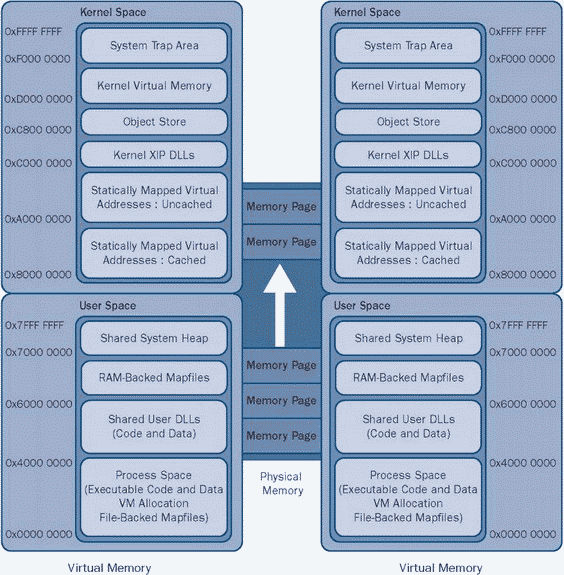Книга: Microsoft Windows Embedded CE 6.0 Exam Preparation Kit
Understanding Memory Access
Understanding Memory Access
Windows Embedded CE works in a virtual memory context and hides the physical memory, as illustrated in Figure 6-8. The operating system relies on the Virtual Memory Manager (VMM) and the processor's Memory Management Unit (MMU) for the translation of the virtual addresses into physical addresses and for other memory access management tasks.

Figure 6-8 Virtual memory regions in kernel space and user space
Physical addresses are not directly addressable by the CPU except during initialization before the kernel has enabled the MMU, yet this does not imply that the physical memory is no longer accessible. In fact, every fully allocated virtual memory page must map to some actual physical page on the target device. Processes in separate virtual address spaces only require a mechanism to map the same physical memory areas into an available virtual memory region to share data. The physical address is the same across all processes running on the system. Only the virtual addresses differ. By translating the physical address per process into a valid virtual address, processes can access the same physical memory region and share data across process boundaries.
As mentioned earlier in this chapter, kernel-mode routines, such as ISRs, can call OALPAtoVA to map a physical address (PA) into a cached or uncached virtual address (VA). Because OALPAtoVA maps the physical address to a virtual address in the kernel space, user-mode processes, such as ISTs, cannot use this function. The kernel space is inaccessible in user mode. However, threads in user-mode processes, such as ISTs, can call the MmMapIoSpace function to map a physical address to a nonpaged, cached or uncached virtual address in the user space. The MmMapIoSpace call results in the creation of a new entry in the MMU Table (TBL) if no match was found or it returns an existing mapping. By calling the MmUnmapIoSpace function, the user- mode process can release the memory again.
NOTE
Physical memory access restrictions
Applications and user-mode drivers cannot access physical device memory directly. User-mode processes must call HalTranslateBusAddress to map the physical device memory range for the bus to a physical system memory address before calling MmMapIoSpace. To convert a bus address into a virtual address in a single function call, use the TransBusAddrToVirtual function, which in turn calls HalTranslateBusAddress and MmMapIoSpace.
- Практическая работа 53. Запуск Access. Работа с объектами базы данных
- EVENT MEMORY SIZE
- Configure Access Control
- Запуск Access. Открытие учебной базы данных Борей
- 7.5.1. Файлы .htaccess
- Основы интерфейса Access 2007
- Листинг 10.2. Пример конфигурационного файла ftpaccess
- Глава 7 Разработка баз данных в программе Access
- Урок 7.1. Знакомство с программой Access
- Access 2007 как реляционная система управления базами данных
- CHAPTER 15 Remote Access with SSH
- Accessing the Command Line




